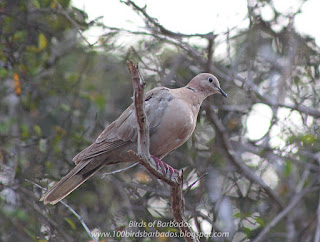 |
| Long Pond looking west at men playing cricket |
On Wednesday evening, after work, the children and I went to the estuary at Long Pond, St. Andrew for an afternoon outdoors and birding fun. It rained for most of the day but not a torrent or a drizzle, but at that calming in between pace. This we figured would make the trail to the beach muddy, so we parked and walk, a trek of about 1/2 mile.
They were Caribbean Martin (Progne dominicensis) zipping right overhead and calling constantly as we walked down the trail. Yellow Warblers (Setophaga petechia) were singing sweetly with two even giving us good looks, but we were not so lucky with the Caribbean Elaenias (Elaenia martinica) and Black-whiskered Vireo (Vireo altiloquus) both heard but not seen until our trek back.
 |
| Golden Warbler |
As we exited the woods looking north towards the river, we were surprised to see a group of men playing cricket on the river bank, then again I should not have been surprised knowing West Indians would play cricket anywhere even in this secluded nowhere.
 |
| A Ruddy Turnstone among the Sargassum Seaweed |
We made our way to the beach which was covered with Sargassum seaweed, and feeding among the weeds were a few shorebirds. Ruddy Turnstones (Arenaria interpres), were the most numerous, but I also saw Sanderlings (Calidris alba) and a few Semipalmated Plovers (Charadrius semipalmatus).
The sandbank separating the calm river from the choppy Atlantic Ocean was still intact and we noticed a disturbance in the sand that may have been a turtle nest. This beach is one of the few places on the island were Leatherback Sea Turtles (Dermochelys coriacea) nest. I contacted my friend Carla from the Barbados Sea Turtle Project who normally runs patrols of this area.
I spent a few minutes checking the beach for birds or any other signs of turtle nesting while the children went off to look for "treasure" which normally equates to pieces of driftwood, shells, glass, or bottles.
 |
| My first Black Swift for the year |
On our way back to the car we saw more Caribbean Martins (Progne dominicensis) hawking for insects over the woods, we counted about 60 birds, but could easily be more. As we exited the woods close to where the vehicle was parked, I noticed the unmistakable shape of a Black Swift (Cypseloides niger) among them. This was my first sighting of this bird for the year and moved my Big Year tally to 78 species.
Here is a list of the 23 species we saw on our evening excursion:
- Scaly-naped Pigeon (Patagioenas squamosa)
- Common Ground Dove (Columbina passerina)
- Zenaida Dove (Zenaida aurita)
- Black Swift (Cypseloides niger)
- Green-throated Carib (Eulampis holosericeus)
- Antillean Crested Hummingbird (Orthorhyncus cristatus)
- Semipalmated Plover (Charadrius semipalmatus)
- Ruddy Turnstone (Arenaria interpres)
- Sanderling (Calidris alba)
- Great Egret (Ardea alba)
- Snowy Egret (Egretta thula)
- Cattle Egret (Bubulcus ibis)
- Green Heron (Butorides virescens)
- Caribbean Elaenia (Elaenia martinica)
- Gray Kingbird (Tyrannus dominicensis)
- Black-whiskered Vireo (Vireo altiloquus)
- Caribbean Martin (Progne dominicensis)
- Shiny Cowbird (Molothrus bonariensis)
- Carib Grackle (Quiscalus lugubris)
- Yellow Warbler (Golden) (Setophaga petechia)
- Bananaquit (Coereba flaveola)
- Barbados Bullfinch (Loxigilla barbadensis)
- Black-faced Grassquit (Melanospiza bicolor)




















